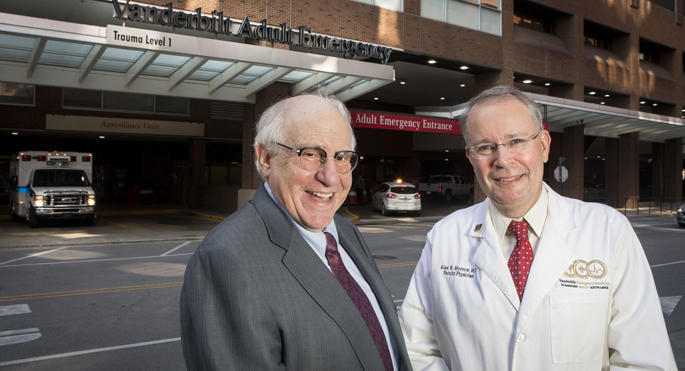
A team of researchers from Vanderbilt Health and Vanderbilt University’s schools of Law, Medicine and Management has received a five-year $1.7 million research grant from the Agency for Healthcare Research and Quality of the Department of Health and Human Services to develop and test “safe-harbor” standards of care based on scientific evidence.
A goal of the project is to reduce the number of unnecessary medical procedures performed primarily to reduce legal liability, a practice known as defensive medicine. Benefits could include lower costs and improved quality of care, resulting from medical patients’ reduced exposure to radiation.
The multi-disciplinary project team is headed by James Blumstein, LLB, University Professor of Constitutional Law and Health Law and Policy, and Alan Storrow, MD, associate professor of Emergency Medicine.
“Our project integrates the perspectives of experts in law and policy, emergency medicine and risk management to examine medical liability with the aim of developing medical malpractice ‘safe harbors’ by establishing standards of care that are accepted by both medical and legal policymakers,” Blumstein said. “We will focus on the legal, policy and empirical dimensions of defensive medicine and develop medical practice protocols with the goal of reducing unnecessary medical procedures that represent a risk to the patient and drive up health care costs.”
Storrow notes that the Choosing Wisely campaign, an American Board of Internal Medicine initiative, has issued detailed guidelines to help patients and providers reduce overuse of potentially harmful diagnostic tests and procedures by engaging in a frank discussion of their risks and benefits in advance. However, the guidelines do not address liability risks, which Storrow believes is why they have yet to be widely adopted by doctors and other providers.
“Until these liability issues are addressed, fear of litigation will continue to drive providers to perform more tests and procedures than may be truly necessary,” Storrow said.
The team will assemble a group of technical experts and advisers to define safe-harbor standards for a narrow set of distinct clinical conditions within emergency medicine. The safe-harbor standards they develop will include both medical and legal components and will be reviewed and considered for approval and adoption by the appropriate federally contracted quality improvement organization.
Emergency medicine practitioners will deploy the safe-harbor protocols at the Vanderbilt University Adult Hospital emergency department. Their efficacy in reducing unnecessary medical procedures, including the effects of the safe-harbor protocols on clinical decision making, adverse reporting, utilization, radiation exposure, patient satisfaction and clinical outcomes, will be examined and evaluated. Northwestern University Medical Center is also participating in the study to provide a basis for comparison.
Blumstein has envisioned such an interdisciplinary research project for more than a decade, having proposed the development of safe-harbor standards of care as a means of curtailing defensive medicine in his 2006 Vanderbilt Law Review article, “Medical Malpractice Standard-Setting: Developing Malpractice ‘Safe Harbors’ as a New Role for QIOs.”















